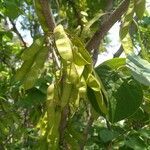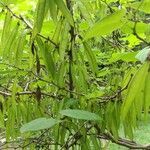Shrubs, 2-5(-8) m tall. Bark and branchlets grayish white. Leaf blade greenish when young with only petiole slightly purple, suborbicular or triangular-orbicular, 5-10 cm, ca. as long as wide or slightly longer than wide, papery, both surfaces usually glabrous, or abaxially puberulent on veins, base shallowly to deeply cordate, margin membranous, transparent when fresh, apex acute. Flowers purplish red, pink, or white, 1-1.3 cm, 2-10-clustered on old branches or especially on trunk; pedicel 3-9 mm; keel tinged with deep purple stripes. Ovary glabrous to densely puberulent; ovules 5-8. Legume greenish, becoming stramineous at maturity, compressed, narrowly oblong, 4-8 × 1-1.2 cm, dorsal and ventral suture equal or subequal, wing 1.5-2 mm, base long attenuate, apex acute or shortly acuminate, with slender and curved beak; stipe 2-4 mm. Seeds 2-6, blackish brown, shiny, broadly oblong, 5-6 × ca. 4 mm. Fl. Mar-Apr, fr. Aug-Oct. 2n = 14*.
More
A shrub. It grows 2-5 m tall. The leaves are a triangle or oval shape and 5-10 cm long. The flowers are purple, red, pink or white. They are 1-1.3 cm across. They are in clusters of 2-10 flowers. The pod is green and oblong and 4-8 cm long by 1 cm wide. There are 2-6 seeds.
Woodland and clearings; at elevations from 600-1,200 metres in W. Hupeh. Commonly cultivated in China, it is rarely found growing in dense forests or limestone areas.
More
It is a tropical plant. It grows in forests in limestone areas. In Sichuan and Yunnan. Arboretum Tasmania.
Can be grown by cuttings or seedlings. Seeds needs soaking.



